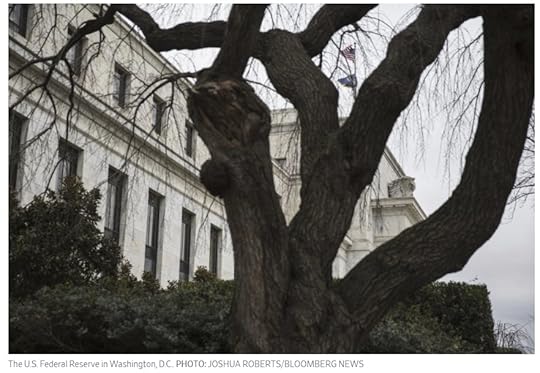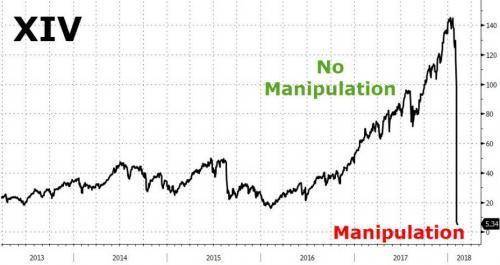Steve Bull's Blog, page 1181
February 24, 2018
Weekly Commentary: Anbang and China’s Mortgage Bubble
The Shanghai Composite traded as high as 3,587 intraday on Monday, January 29th, a more than two-year high. This followed the S&P500’s all-time closing high (2,873) on the previous Friday. On February 9th, the Shanghai Composite traded as low as 3,063, a 14.6% decline from trading highs just nine sessions earlier. In U.S. trading on February 9th, the S&P500 posted an intraday low of 2,533, a 10.7% drop from January 26th highs. Based on Friday’s closing prices, the Shanghai Composite had recovered 43% of recent declines and the S&P500 70%.
Global equities markets demonstrated notably strong correlations during the recent selloff. Few markets, however, tracked U.S. trading closer than Chinese shares. From the Bubble analysis perspective, tight market correlations provide confirmation of the global Bubble thesis. It’s also not surprising that Chinese markets were keenly sensitive to the abrupt drop in U.S. stocks. The U.S. and China are dual linchpins to increasingly vulnerable global Bubble Dynamics. Moreover, intensifying fragilities in Chinese Credit – and finance more generally – ensure China is keenly sensitive to any indication of a faltering U.S. Bubble.
February 21 – Bloomberg: “China stopped updating its homegrown version of the VIX Index, taking another step to discourage speculation in equity-linked options after authorities tightened trading restrictions last week. State-run China Securities Index Co. didn’t publish a value for the SSE 50 ETF Volatility Index on its website Thursday. An employee who answered CSI’s inquiry line said the company stopped updating the measure to work on an upgrade. The move was designed to curb activity in the options market, said people familiar with the matter… It’s unclear when the index will resume.”
Derivatives rule the world. Of course, Chinese authorities had few issues with booming options trading when markets were posting gains. Here in the U.S., regulators will supposedly now keep a more watchful eye on VIX-related products.
…click on the above link to read the rest of the article…
US Aggression in Syria – an Imperialist Blueprint

US Aggression in Syria – an Imperialist Blueprint
Syria’s prolonged conflict and misery going into its eighth year is no accident. It is by design. American imperialist design.
First though, we note the increasing reprehensible absurdity in this conflict.
Turkey, which invaded Syria nearly a month ago in violation of Syria’s sovereignty, this week accused Damascus of “terrorism” after the Syrian government sent forces to defend the northern area near Afrin under assault from Turkey.
Meanwhile, US forces, again illegally occupying Syria in violation of international law, claim to be fighting terrorist militia. Yet more often than not, the Americans are affording protection to various terrorist groups. Then when Syrian state forces advance to clear the terror groups, the US claims it is acting in “self-defense” by massacring whole units of the Syrian army.
Further absurdity is due to France, which has been bombing Syria illegally along with the US and Britain, warning Iranian militia, who are legally present in Syria owing to Damascus’ approval, that they have to withdraw from the country.
As if the situation couldn’t get any more bizarre, Israel has carried out more than 100 air strikes on Syria, claiming that the aggression are “acts of self-defense”.
The Syrian government of President Assad is the sovereign authority of the country, as recognized by UN resolutions. It has the right to defend its nation and to reclaim areas which have been usurped by illegally armed groups. Virtually all of these insurgents are foreign-backed proxies who have been waging a war for regime change according to the designs of their foreign sponsors.
The only armed forces legally present in Syria are those of Russia, Iran and associated militia who have been requested legally by the Syrian government to assist in defending the state from a foreign-backed war.
…click on the above link to read the rest of the article…
We Can’t Keep Expecting the Federal Government to Fix Things
Whatever your solution may be, the path to change a nation starts locally.
It’s happened again, another tragedy in America, and once more we hear the cries for systematic change echo from coast to coast. Instead of berating you with countless policy prescriptions in the aftermath, and whether or not they will deter these events in the future, I would like to offer a piece of advice to those seeking to come out of this with more than just “thoughts and prayers” that I think has been grossly overlooked and underutilized in society today. Rather than entrench ourselves in the emotional mudslinging within social media anytime an event like this occurs, we ought to turn inward, towards our own backyards and communities, and recognize that the path to political change starts locally, not nationally.
We need a new — or rather, old — approach regarding societal problems that have become deep-rooted today. Right now, the cultural norm, whether due to technological advances that put us in closer contact with one another or the process of political centralization, is to call for change on a federal level any time a problem is observed. This wasn’t always the case, and I rather believe this practice taking hold is a contributing factor in these tragedies.
Diversification and Innovation
Before social media allowed us to criticize the viewpoints of people on different continents from the comfort of our living room, and before politics became completely centered around what the federal government was doing, people aired their grievances in their local communities. If you noticed what you thought was an urgent problem within your child’s school, for example, you wouldn’t tweet at a senator in Washington, D.C., you’d go to your local school board meeting. And as it turns out, that’s still the most effective route.
…click on the above link to read the rest of the article…
Farewell to Development
As inequality and environmental degradation worsen, the search is on not only for alternative development models but also for alternatives to development itself. Leading post-development theorist Arturo Escobar, co-editor of The Post-Development Dictionary and author of Design for the Pluriverse, discusses the fight for pluralism and justice in Latin America with Allen White, Senior Fellow at the Tellus Institute.
Tell us about your personal journey. What inspired you to become a critic of mainstream development theory and a pioneer of a new paradigm?
I grew up in Cali, Colombia, a city of a half million people, in the 1960s, in many ways a typical member of a generation seeking modernization and development, in the mainstream sense of the words. Both of my parents came from the countryside—my father from a very poor peasant family and my mother from a middle-class family in a small town. They migrated to Cali to improve their lives and secure opportunities for their children. We attended good elementary and high schools, which required substantial sacrifice on the part of my parents. Upon graduation, I attended Cali’s public university, Universidad del Valle (the only affordable option), where I majored in chemical engineering.
As I was nearing completion of my undergraduate degree (1975), I realized two things. First, I didn’t want to work as a chemical engineer because that probably meant working for a large, multinational company. Second, I was becoming very interested in questions of food and hunger. Through acquaintances in Colombia, and with knowledge obtained through study of UN documents about the hunger crisis of the early 1970s, I was awarded a fellowship to begin a Master’s Degree in international nutrition and food science at Cornell University in the late 1970s.
…click on the above link to read the rest of the article…
BP Sees Peak Oil Demand In 2030s

BP says oil demand will peak in the 2030s, and that EVs will rise 100-fold to capture about a third of the car market.
BP released its annual Energy Outlook, with forecasts through 2040. Unlike in years past, this version sees more upheaval on the horizon as the energy landscape evolves rapidly. “Indeed, the continuing rapid growth of renewables is leading to the most diversified fuel mix ever seen,” BP CEO Bob Dudley said in a statement. “Abundant and diversified energy supplies will make for a challenging marketplace. Don’t be fooled by the recent firming in oil prices: the focus on efficiency, reliability and capital discipline is here to stay.”
BP believes that just about all of the growth in energy demand will come from fast-growing developing economies, with China and India alone accounting for half of the total growth in global energy demand through 2040.
BP offered several different forecasts, but all predict a peak in oil demand in the 2030s, with varying degrees of decline thereafter. Its central forecast sees peak oil demand in the mid-2030s at about 110 million barrels per day (mb/d), with consumption plateauing and declining through 2040 and beyond. In other words, demand grows for another two decades, rising by 15 mb/d, before consumption tops out.
BP sees the number of EVs on the road surging to 320 million by 2040, capturing about a third of the market in terms of miles traveled. That equates roughly to a 100-fold increase from the 3 million EVs on the road today. It is also sharply up from the 100 million EVs BP expected to be on the road in 2035 in last year’s Energy Outlook.
…click on the above link to read the rest of the article…
It Was Not Effective, But We’ll Do It Again

It Was Not Effective, But We’ll Do It Again
Boston Fed President Eric Rosengren has some interesting comments about QE today.
The Bond Buyer reports Rosengren Expects Fed to Again Resort to Asset Purchases.
Although large scale asset purchase programs may not be as effective as previously believed, Federal Reserve Bank of Boston President Eric Rosengren said Friday, “it is quite likely” that the programs will be needed in the future.
Crisis-Era Failures
The Wall Street Journal reports Fed’s Crisis-Era, Bond-Buying Plan Was Largely Ineffective, Economists Say.
The Federal Reserve’s signature bond buying stimulus program undertaken during and in the wake of the financial crisis was largely a dud for the economy, argues a new paper authored by a group of prominent economists.
The paper, which was to be presented Friday at a conference held in New York by the University of Chicago Booth School of Business, takes aim at the central bank’s controversial purchases of long-term Treasury and mortgage debt.
Given the unorthodox nature of the stimulus, arriving in an economy undergoing huge stress, central bankers and academics have long struggled to understand what the Fed got for a policy that took its portfolio of cash and bonds from a pre-crisis level of just over $800 billion in 2007 to a peak of $4.5 trillion.
“We find that Fed actions and announcements were not a dominant determinant of 10-year yields and that whatever the initial impact of some Fed actions or announcements, the effects tended not to persist,” the paper’s authors wrote. Their findings were based on a study of Fed policy announcements referenced against market reactions.
William Dudley of the Federal Reserve Bank of New York and Eric Rosengren of the Federal Reserve Bank of Boston both said on a panel discussing the paper’s findings that they agree it’s hard to understand the exact impact of the bond buying.
…click on the above link to read the rest of the article…
Their Meddlers and Ours

Photo by Satish Krishnamurthy | CC BY 2.0
By the end of World War II, the United States had become a serial meddler in the affairs of the nations of the world, friend and foe alike.
American intelligence services took particular aim at Third World and Western countries with large Communist Parties, and at countries on the other side of what used to be called “the Iron Curtain.”
Meddling there took some doing before the implosion of the Soviet Union. It still does in China and North Korea, and in countries with strong states, like Iran, that resist American domination. However, our intelligence services are well resourced and determined.
They are also inept. Therefore, their machinations fail as often as not.
Even so, with the Soviet Union gone, the European component of the formerly Communist world became easy prey.
It did not take long, in those circumstances, for American meddlers to become cruder and less subtle. But it was not until the Obama period that the extent of the transformation became too obvious to miss.
Thanks to Hillary Clinton’s stewardship of the empire’s affairs during her tenure as Secretary of State, and to the exploits of the liberal imperialists she and Barack Obama left in charge after she quit the State Department, the level of American brazenness in that part of the world has substantially increased.
This was especially evident in Ukraine, a former Soviet republic, adjacent to Russia, deeply connected, historically and culturally, to the old Russian and Soviet empires.
In these circumstances, what fair-minded person could blame the Russians for wanting to meddle in our affairs?
Our intelligence services claim that Russians meddled in the 2016 presidential election, and that they are gearing up to meddle again in the midterm elections later this year.
…click on the above link to read the rest of the article…
Is the CIA So Bad that Even When It Tells the Truth It Adds-In Lies?

Is the CIA So Bad that Even When It Tells the Truth It Adds-In Lies?
On Sunday, February 17th, I was surprised to see in the reliably neoconservative newspaper, New York Times, an ‘opinion’-article headlined with the distinctively non-neoconservative title, “Russia Isn’t the Only One Meddling in Elections. We Do It, Too.” But, then, I got to the neocon core, in the article itself:
But in recent decades, both Mr. Hall and Mr. Johnson argued, Russian and American interferences in elections have not been morally equivalent. American interventions have generally been aimed at helping non-authoritarian candidates challenge dictators or otherwise promoting democracy. Russia has more often intervened to disrupt democracy or promote authoritarian rule, they said.
Equating the two, Mr. Hall says, “is like saying cops and bad guys are the same because they both have guns — the motivation matters.”
That’s just a typical neocon lie — reality turned upside-down, black-is-white and white-is-black.
When the CIA hired Iranian mercenaries to rebel against and overthrow the progressive democratically elected Iranian Prime Minister Mohammed Mosaddegh in 1953 and installed there a dictatorship (which lasted till 1979); and did the same to overthrow and replace the progressive democratically elected Guatemalan President Jacobo Arbenz in 1954; and, more recently, in 2009, helped Honduras’s aristocracy to overthrow that country’s progressive democratically elected President Manuel Zelaya, and to cement and make permanent their new and fascist regime; and, in 2014, perpetrated a brutal coup in Ukraine overthrowing that country’s democratically elected but corrupt (like all prior post-communist Ukrainian Presidents were) President Viktor Yanukovych — even the Soviets (including the pre-1991 and pre-independent Russians) weren’t that bad; and a 1992 classic BBC documentary about the CIA’s having set up in Western Europe during the Cold War numerous deadly terrorist incidents which were designed so as to be blamed on ‘communists’, makes clear, that the US CIA is a spiritual implant into the US Government, of Adolf Hitler’s Nazi (but now American) Gehlen Organization — a darling of the CIA Director Alan Dulles, and which is still today the CIA’s spirit.
…click on the above link to read the rest of the article…
February 23, 2018
Misconduct, Manipulation, Or Malfeasance? – US Regulators Begin Probe Of VIX Funds
Ten days after the reality of “rampant manipulation” in VIX was exposed yet again, perhaps because this time the market went down, US regulators are reportedly escalating their investigations into whether any wrongdoing occurred within VIX ETPs.

Following previous reports that The Financial Industry Regulatory Authority (FINRA) was scrutinizing whether traders placed bets on S&P 500 options in order to influence prices for VIX futures, and a whistleblower’s detailed explanation of how easy it is to spoof VIX’s tail to wag the market’s dog; Bloomberg reports that The Securities and Exchange Commission and the Commodity Futures Trading Commission have been conducting a broad review of trading since Feb. 5, when volatility spiked and investors lost billions of dollars, several people familiar with the matter said.
As a reminder, according to his letter, the whistleblower blames this VIX manipulation as the driver of last week’s volatility complex collapse:
“We contend that the liquidation of the VIX ETPs last week was not due solely to flaws in the design of these products, but instead was driven largely by a rampant manipulation of the VIX index,”
And, Bloomberg notes that after the losses, SEC officials reached out to Credit Suisse, a person with direct knowledge of the conversations said. Neither Credit Suisse nor ProShares have been accused of any wrongdoing. The regulators’ examinations are at an early stage and won’t necessarily lead to sanctions or new rules.
As another reminder, in May of last year we academic confirmation of the rigged nature the US equity market’s volatility complex, when a scientific study found “systemic VIX auction settlement manipulation.”
Two University of Texas at Austin finance professors found “large transient deviations in VIX prices” around the morning auction,“consistent with market manipulation.”
…click on the above link to read the rest of the article…
The Big Bot Conspiracy
Bots. Is there anything they can’t do?
The Internet Research Agency indictment accuses a troll bot farm of trying to influence the election in what the media claims is the worst attack on America since Pearl Harbor. 9/11 need not apply.
Bots are everywhere.
 “Bots Are Trying to Help Populists Win Italy’s Election,” claims Bloomberg. “Russian Bots Are Using 2016 Tactics to Hijack the Gun Debate,” shrieks Vanity Fair. ABC spins that bots are trying to make Black Panther look bad. “Rampaging Twitter ‘bots’ bred in Suffolk farmhouse,” the London Times asserts.
“Bots Are Trying to Help Populists Win Italy’s Election,” claims Bloomberg. “Russian Bots Are Using 2016 Tactics to Hijack the Gun Debate,” shrieks Vanity Fair. ABC spins that bots are trying to make Black Panther look bad. “Rampaging Twitter ‘bots’ bred in Suffolk farmhouse,” the London Times asserts.
This media madness might make you think that bots are some sort of new and advanced technology. But you can see them in the comments and they’ve been around forever. Automated programs that log into social media accounts are not a new technology. Internet users of a bygone era remember seeing them in chat rooms and on bulletin boards without ever rampaging around Suffolk farmhouses.
Bots have become a convenient media scapegoat. The new formula is “Bots + Thing We Disagree With = Proof We’re Right”. That’s why there are stories claiming that Russian bots are tweeting against gun control or Islamic migration. And it explains the “Russian Bots Rigged the Election for Trump” meme.
Bots are an informational technique. Media spin reverse engineers the technique to discredit the idea. Not only is that a fallacy, but bots just piggyback on popular trends to gain influence. Russian bots don’t tweet about gun control because they care about guns, but because they get retweeted. The same was true of the bots promoting Bernie Sanders and Donald Trump. There are a million brands doing the same thing with bots and influencers. But that’s okay because they push politically correct messages.
And that’s the bot double standard.
…click on the above link to read the rest of the article…



